Seven Questions Over Breakfast with Rosalyn Schanzer
 October 20th, 2011 by jules
October 20th, 2011 by jules

This is the spellbinding opening of Chapter 4 in author/illustrator Rosalyn Schanzer’s Witches! The Absolutely True Tale of Disaster in Salem, published by National Geographic Children’s Books in September of this year. Two terrified men think they see a beast fly up into the air and turn into the spirits of three witches, while the three accused “witches” are in jail at the time.
The Society of Illustrator’s 2011 Original Art Opening Reception and Awards Presentation will be next Thursday, October 27th, in New York City, and you can bet Rosalyn will be there, as she was awarded the Gold Medal for the aforementioned nonfiction title. Though I was a jury member this year, I can’t make it to the reception, but the least I can do is feature Rosalyn here at 7-Imp right before her big night. (To be fair, I should point out that the two Silver Medal winners, Kadir Nelson and Lane Smith, have previously visited 7-Imp — here and here, respectively.)
 Rosalyn, pictured here in disguise, has been writing and illustrating books for years now, and—as you can see in the Q & A below—is very passionate about nonfiction and bringing history to life for young readers. As she explains this morning, she is also very involved in I.N.K.: Interesting Nonfiction for Kids, a site which features nonfiction writers and illustrators and offers opportunities for others to see how they practice their craft. (If you haven’t visited I.N.K. yet, by all means, take some time right now to go have a look at this impressive site. Rosalyn and I will wait patiently here for you. I can whistle.)
Rosalyn, pictured here in disguise, has been writing and illustrating books for years now, and—as you can see in the Q & A below—is very passionate about nonfiction and bringing history to life for young readers. As she explains this morning, she is also very involved in I.N.K.: Interesting Nonfiction for Kids, a site which features nonfiction writers and illustrators and offers opportunities for others to see how they practice their craft. (If you haven’t visited I.N.K. yet, by all means, take some time right now to go have a look at this impressive site. Rosalyn and I will wait patiently here for you. I can whistle.)
When I asked Rosalyn about breakfast this morning, she first responded with, “uh-oh…really?” Should I be scared? Turns out no. “It’s not exactly your typical bacon and eggs: Shredded Wheat with walnuts or pecans, a lot of fresh blueberries, a lot of fresh strawberries, a West Virginia peach from the farmers’ market (in the winter, sub one banana), some raisins, and skim milk. Then I eat some chocolate. My excuse is that I’m a competitive swimmer and I have to carb-load.”
I can deal with this, especially the chocolate part, as long as she lets me brew some strong coffee.
I’m happy Rosalyn visited today (and not just ’cause she’s originally from Tennessee). She’s been making engaging nonfiction titles for children for years, and it’s lovely to see her awarded by the Society of Illustrators for her arresting scratchboard art in Witches! … Without further ado, here she is, and I thank her for visiting.
Jules: Are you an illustrator or author/illustrator?
Rosalyn: Both -– gives the control freak in me the most control over my own books.
Jules: Can you list your books-to-date?
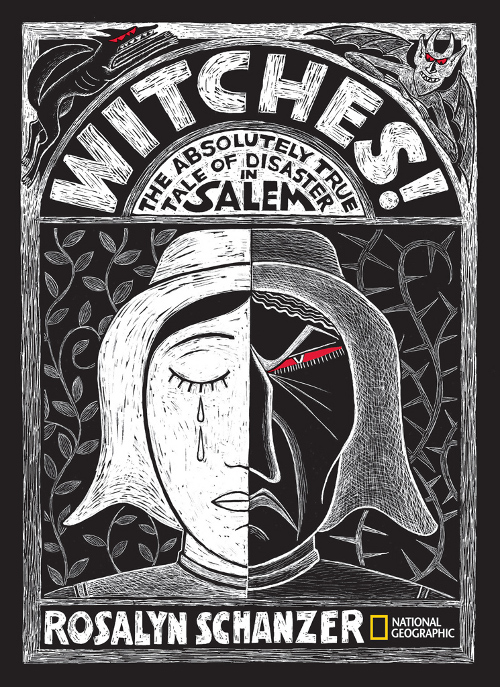
Rosalyn: Here are the books in print, starting with the most recent and working backwards (OMG, three titles include exclamation points, something I never noticed. That’s supposed to be bad, but hey…):
- Witches! The Absolutely True Tale of Disaster in Salem
- What Darwin Saw: The Journey that Changed the World
- John Smith Escapes Again!
- George vs. George: The American Revolution as Seen from Both Sides
- How Ben Franklin Stole the Lightning
- The Old Chisholm Trail: A Cowboy Song
- Gold Fever! Tales from the California Gold Rush
- How We Crossed the West: The Adventures of Lewis and Clark
The Adventures of Lewis and Clark
(Click to enlarge)
These are not in print, but I like them anyway:


Jules: What is your usual medium, or––if you use a variety—your preferred one?
Rosalyn: I am easily bored, so I’ve tried out almost every media known to man and beast, except for oil paint, because it takes too long to dry. I change styles all the time, too (not a good way to be recognized as an artist).
As an aside, I’ve been using talk balloons in my illustrations for a good million years, give or take a few. Problem is, this means you can’t hang your paintings on a wall, because the words in the balloons are almost always set in type, so the balloons in the original art have to be empty. Talk balloons used to be frowned upon by everyone but me and the comics-addicts, but now they’re spoze to be cool.
(Click to enlarge)
If you want an actual list of mediums (abbreviated), I’ve painted entire books on wood veneer and on rough canvas and on various and sundry kinds of paper with every possible texture (but mostly cold press Strathmore Bristol Board). I use gouache or acrylics or acrylic gouaches or concentrated analine ink dyes, like Luma, which they don’t make any more. Beware: they also fade. I do lots of outlining with various kinds of pens or even archival magic markers (another bad thing I love). I add texture with colored pencils or Cray-pas. I also use cut paper and have done a few collages and some fake woodcuts using, um, potatoes, among other stuff.
(Click to enlarge)
Color is my fave; sometimes it saves my bacon if the art isn’t perfect enough. But Witches!, my latest book, was done in black and white on Ampersand Scratchbord (yes, “bord”) with small spots of red added digitally.
minus the title and boxed area,” Rosalyn says.
(Click to enlarge)
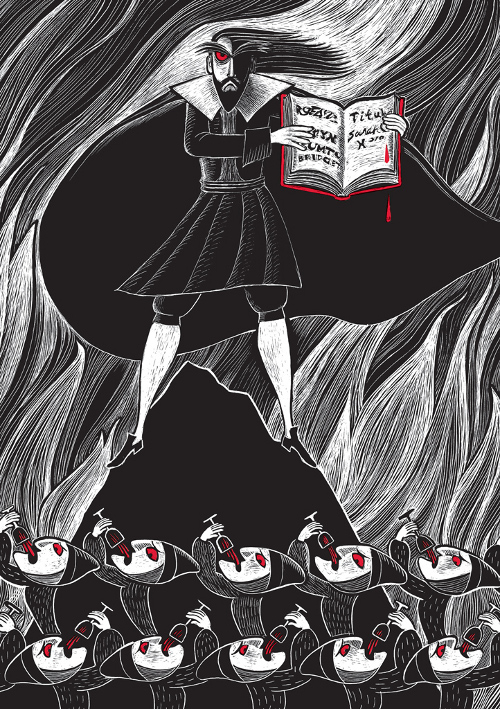
Jules: If you have illustrated for various age ranges (such as, both picture books and early reader books OR, say, picture books and chapter books), can you briefly discuss the differences, if any, in illustrating for one age group to another?
Rosalyn: At one time or another, I’ve illustrated tons of books, posters, pop-up books, games, and magazine and newspaper articles for every age group on the planet, from toddlers through adults, and except for about fifteen simple board books for very tiny kids, the styles I use work well for most everyone.
Subject matter is a horse of a different color. My new YA book uses a lot of symbolism that younger kids might not get, and one or two of the pictures are way too evil for little people.
Jules: Where are your stompin’ grounds?
Rosalyn: I stomp around in Fairfax Station, VA, outside of D.C.
(Click to enlarge)
Jules: Can you briefly tell me about your road to publication?
Rosalyn: After college, I worked in that large famous greeting card company in Kansas City for seven entire years in the humorous greeting card department and the book department, till I decided it was high time to freelance. You’d be very surprised to hear who else used to work there, but they ain’t talking.
Anyway, I instantly wrote a children’s book, called The Beggar’s Treasure, did a sample illustration, and mailed it straight to New York right over the transom to Holt Rinehart and Winston. Then they instantly accepted it. This was so easy that I thought I was home-free, even though I still lived in Kansas City, Missouri.
Not. I ended up illustrating other people’s books and junk via a New York agent for the longest time. The pay was great, if you became an Art Ho and illustrated five pages a day, but needless to say, I like what I’m doing now a whole lot better.
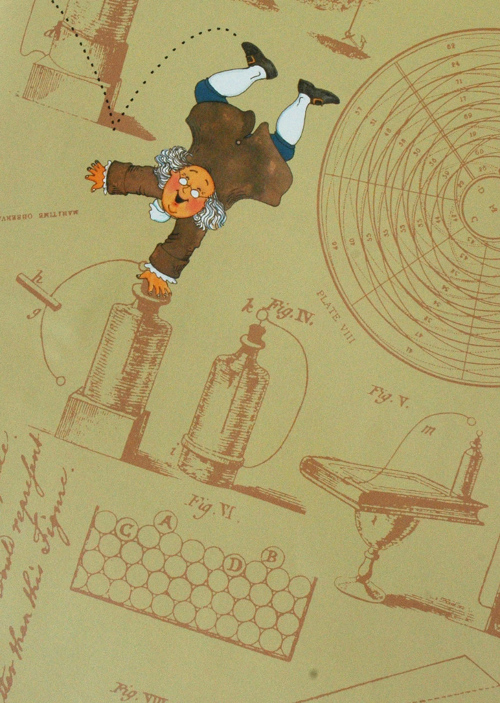
Those are Ben’s drawings of his inventions in the background.”
(Click to enlarge)
Jules: Can you please point readers to your web site and/or blog?
Rosalyn: www.rosalynschanzer.com (my personal website) and inkrethink.blogspot.com (I.N.K.: Interesting Nonfiction for Kids, which features a slew of the best nonfiction writers around). I’m also part of this related site.
And here’s a link to my Witches! trailer (also included below here):
It shows how I did the artwork and, besides, it’s scary and has weird music.
Jules: If you do school visits, tell me what they’re like.
Rosalyn: Yes, I do school visits all the time. I usually tell an amazing story from history (or not from history), using one of my books. I also integrate a fast-paced slideshow of the art so that it’s kinda like watching a movie.
-a.jpg)
There’s lots of interaction with the kids, and when I talk to the littlest ones, we get volunteers to dress up in costumes, make funny sound effects, and sing. Sometimes with older kids we add a funny T/F quiz about serious stuff. For more info, you can go here.
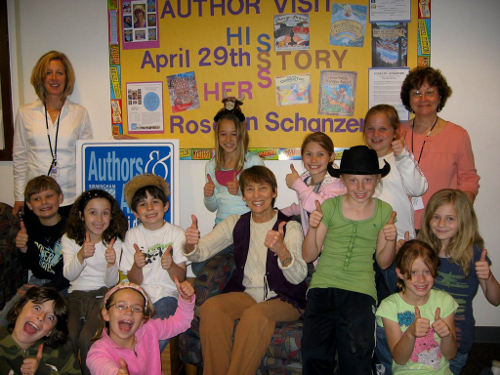
Jules: If you teach illustration, by chance, tell me how that influences your work as an illustrator.
Rosalyn: Many moons ago when my kids were little, I used to teach illustration to graduate students at George Washington University. I loved it. I guess the teaching process helped me consolidate every interesting thing I’d gleaned over time. Teaching also gave me the chance to do a show-and-tell about some very cool artwork by my favorite illustrators, plus tons of other well-designed stuff I’d collected. This was fun, because this was in the early 1990s, and there was no such thing as the internet yet. I tried to make sure everyone developed a style of his or her own, and I got to tell secret stories about illustration to people who actually wanted to hear them. The students were tuned-in and inspiring, and in the bargain, I could get out of my house and talk to people who were closer to my own height for a change!
(Click to enlarge)
You could probably say that my school visits and talks to other grownups are like teaching, too. I think it’s always fun and important to keep in touch with your readers – and it sure beats staying locked up in your studio 24-7 and looking at shadows on your cave wall/radio/TV to figure out what the world is about. Even though I’ve heard plenty of illustrators say that they draw pictures and write books for their own selves (me, too!), I think we think we should stay in tune with real kids as often as possible.
(Click to enlarge)
The cinematographer in me liked showing this scene from above.”
(Click to enlarge)
Jules: Any new titles/projects you might be working on now that you can tell me about?
Rosalyn: Well, I’m working on one project right now with a group of highly respected nonfiction authors, who have a website called INK THINK TANK. The aim is to get schools excited about using great nonfiction books in their classrooms as a part of their own curriculum (so much more compelling, fun, and accurate than textbooks!). There’s a free database on the site that can print out unique lists of award-winning nonfiction books for whatever any given teacher is teaching at the time, and each book is tied directly to the National Education Standards. We also visit schools and do teacher in-services and other special programs via live videoconferencing. This is the direct link.
 Coffee’s ready, raisins are out, and the table’s set now for seven questions over breakfast. Let’s get a bit more detailed, and I thank Rosalyn again for visiting 7-Imp.
Coffee’s ready, raisins are out, and the table’s set now for seven questions over breakfast. Let’s get a bit more detailed, and I thank Rosalyn again for visiting 7-Imp.
1. Jules: What exactly is your process when you are illustrating a book? You can start wherever you’d like when answering: getting initial ideas, starting to illustrate, or even what it’s like under deadline, etc. Do you outline a great deal of the book before you illustrate or just let your muse lead you on and see where you end up?
Rosalyn: First, I write the manuscript (another topic entirely), making sure to consider the art somewhere in the back of my little brain. After all, how else would I know where to put the pictures if I didn’t know how much space the words would gobble up? I LOVE writing books, but the only bad thing about this entire process is that I never have more than three months left to do the artwork, whether my book is 32 pages long or 144 pages long. My art is extremely complicated, and the pictures in my nonfiction books involve a ton of research, so doing the illustrations in such a short time is the best/worst way I know to become a prisoner in your own abode.
(Click to enlarge)
Anyway, next I make a storyboard by drawing about 6 or 8 rectangular boxes on each of several 8½” X 11” pieces of computer paper; each box has a vertical line down the center for the gutter and represents a 2/page spread. Then I do a tiny rough pencil sketch inside each box, one for each spread. I like being able to see several spreads at once so that I can make sure that the art tells a story, moves along in the most interesting way possible, and isn’t too repetitive. I like this loose way of working, because I can change my mind easily without going to a lot of trouble perfecting pictures I might decide not to use.
When I’m satisfied with the storyboard, I do full-sized finished pencil sketches on tracing paper for each spread with the type taped in place, and then I trace the sketches down onto whatever paper or board or canvas, etc. I’m using for the finished art.
as it would have looked back in the day.”
(Click to enlarge)
Then I do the finished art. That’s by far the easiest and most fun part of my job, if you ask me. I no longer have to think up unique ideas or go through piles of research (even though I like all that stuff, too). And I get to listen to books on tape or The Moth or This American Life on the radio or play all kinds of music, while I mess around with the color till I’m finally done.
Then I go to a foreign country and take pictures.
on every page!”
(Click to enlarge)
(Click to enlarge)
(Click to enlarge)
2. Jules: Describe your studio or usual work space.
Rosalyn: I can’t believe it’s mine, even though it’s not at all new and is usually a mess.
I have a gigantic studio in a walkout basement with a deck overlooking a mini-forest, a creek, and a whole bunch of birds. I designed the studio my own self in an earlier incarnation with a left-handed person in mind. There’s an extremely long oak desk with a light box and a great big space for doing art. It also has room for tons of drawers and shelves, containing every imaginable kind of art supply and paper, almost all of it in convenient places that I can reach without standing up; then there’s room for a big computer with two monitors so that I can work on the writing on one of them, while bringing up research material and email, etc. on the other; there’s a giant cutting board (the best investment I ever made); and there’s one of my two sets of oak flat files with 14 drawers total.
A gazillion oak bookshelves line the walls and spill over with waaaaay too many books. On the walls are masks from New Guinea, Korea, and New Orleans (what a combo), lots of weird carved beasts from Oaxaca, and a bunch of posters and art and photos. (Then there’s the floor. It’s full of stacks of research material and a ton of my granddaughter’s toys — damn…now you know I’m old.)

to make his famous journey.”
(Click to enlarge)
3. Jules: As a book lover, it interests me: What books or authors and/or illustrators influenced you as an early reader?
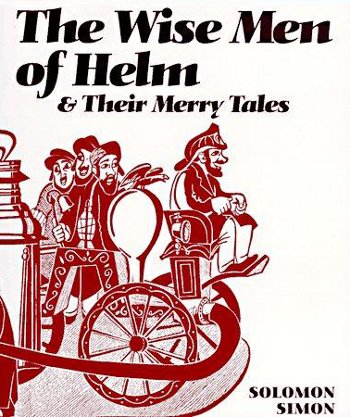 Rosalyn: We’re talking elementary school here. I liked anything funny: Mad magazine (which I always memorized), Dr. Seuss for Bartholomew and the Oobleck, Lewis Carroll for his Jabberwocky poem, Solomon Simon for The Wise Men of Helm (reminds me of today’s Congress, except Helm was funny), and Al Capp for Li’l Abner. (Of course, Al used talk balloons too, remember? Plus I was born in Tennessee, sorta like Li’l Abner…).
Rosalyn: We’re talking elementary school here. I liked anything funny: Mad magazine (which I always memorized), Dr. Seuss for Bartholomew and the Oobleck, Lewis Carroll for his Jabberwocky poem, Solomon Simon for The Wise Men of Helm (reminds me of today’s Congress, except Helm was funny), and Al Capp for Li’l Abner. (Of course, Al used talk balloons too, remember? Plus I was born in Tennessee, sorta like Li’l Abner…).
Those guys’ art was great for the period, but the art that influenced me the most came later.
4. Jules: If you could have three (living) authors or illustrators—whom you have not yet met—over for coffee or a glass of rich, red wine, whom would you choose?
Rosalyn: This is cheating, because I’ve met a fair number of the really good artists (albeit, mostly briefly), and I also have a semi-long list of the best of the rest. Besides, what if my all-time idols turned out to be boring?
 But, as for artists, how about Tomi Ungerer, Etienne Delessert, and Milton Glaser (not generally a book guy, but oh well…).
But, as for artists, how about Tomi Ungerer, Etienne Delessert, and Milton Glaser (not generally a book guy, but oh well…).
And, as for authors, I like the dead guys. I wrote about a couple of them: Charles Darwin I would love to meet; also the great escape artist Captain John Smith to see what he was like in real life. Then to be more contemporary, I pick Shel Silverstein, just because of Uncle Shelby’s ABZ Book. As I told you earlier, Jules, this book made me convince two innocent little kids to throw raw eggs up in the air as high as they could so that the giant who lives in the ceiling would reach down and catch them. I did this, even though I was supposedly a grown-up.
5. Jules: What is currently in rotation on your iPod or loaded in your CD player? Do you listen to music while you create books?
Rosalyn: Um, N/A exactly…..sorry. But I listen to all kinds of music, except for opera and Country and Western.
Halley’s Comet was getting ready to attack.”
(Click to enlarge)
6. Jules: What’s one thing that most people don’t know about you?
Rosalyn: Well, you already found out about my breakfast. But most people who swim don’t know I’m a Serious Author/Illustrator, and most people who write and illustrate don’t usually know I’m a Serious Swimmer — and hardly anybody knows I’m a Serious Photographer.
Or, if you prefer this one, I once sailed a famous racing sailboat from Bermuda to Boston.
(Click to enlarge)
7. Jules: Is there something you wish interviewers would ask you — but never do? Feel free to ask and respond here.
Rosalyn: Interrogator: Why in the world do you write mostly nonfiction history books for kids when they take at least ten times longer than fiction to write and illustrate and are so much less likely to become blockbusters?
 Me: I dunno. I actually love writing fiction. But unlike the mind-numbing material you used to read in your textbooks, true stories from history can knock the socks right off your feet. After all, these tales have lasted so long, because they include the very best — and worst — adventures of all time. Besides, you get to be a spy who can virtually take the roofs off of famous people’s houses and look inside at all their secrets without getting arrested. It’s actually legit to read their most private letters and journals or their lists of money owed or their flashes of sheer genius or their twisted evil little musings.
Me: I dunno. I actually love writing fiction. But unlike the mind-numbing material you used to read in your textbooks, true stories from history can knock the socks right off your feet. After all, these tales have lasted so long, because they include the very best — and worst — adventures of all time. Besides, you get to be a spy who can virtually take the roofs off of famous people’s houses and look inside at all their secrets without getting arrested. It’s actually legit to read their most private letters and journals or their lists of money owed or their flashes of sheer genius or their twisted evil little musings.
And there’s more: Without getting decapitated, you can go along for the ride with history’s most daring explorers and warriors and earth-shakers and heroes and villains. And the art part lets you examine all their weird clothes, see what they actually looked like at different ages, and figure out how their boats and their weapons and their ceremonies and their whole strange worlds worked way back through the mists of time.
In other words, it’s fun.

Jules: What is your favorite word?
Rosalyn: “Onomatopoeia,” because it sounds cool and hardly anybody can spell it. Or how about “money”?
Jules: What is your least favorite word?
Rosalyn: “Booger,” even though everybody can spell it. Or “money.”
Jules: What turns you on creatively, spiritually or emotionally?
Rosalyn: World travel to places where most people don’t go.
Jules: What turns you off?
Rosalyn: Not traveling.
Jules: What is your favorite curse word? (optional)
Rosalyn: I’m an equal opportunity curse-word user. But when my husband works on his many hobbies, he uses a recurrent five-syllable curse word that cannot be repeated in polite company.
Jules: What sound or noise do you love?
Rosalyn: The little birdies. And my 15-month old granddaughter laffin’ when we throw stuffed animals up at the ceiling and they come crashing down. Apparently, I have a thing about ceilings, but I don’t give her any eggs.
Jules: What sound or noise do you hate?
Rosalyn: Idiotic political pundits yelling at each other on TV news shows.
Jules: What profession other than your own would you like to attempt?
Rosalyn: An international photojournalist, of course.
Jules: What profession would you not like to do?
Rosalyn: A plumber’s helper.
Jules: If Heaven exists, what would you like to hear God say when you arrive at the Pearly Gates?
Rosalyn: I don’t know, but besides asking what I’m doing there, he will probably want to know why I wrote that evil little story about his deal with the devil.
All artwork and images used with permission of Rosalyn Schanzer. All rights reserved.
The spiffy and slightly sinister gentleman introducing the Pivot Questionnaire is Alfred, © 2009 Matt Phelan.
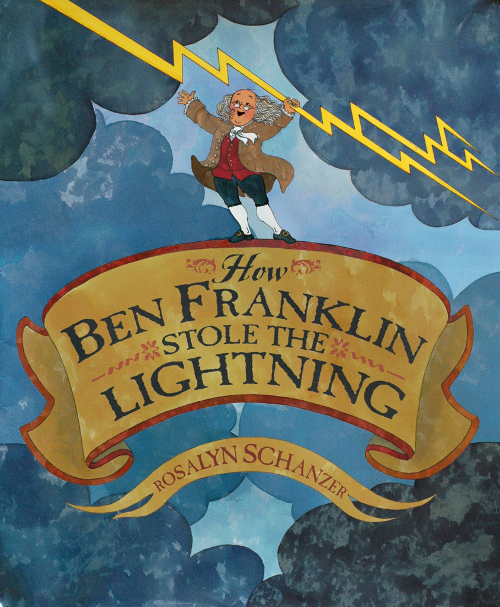

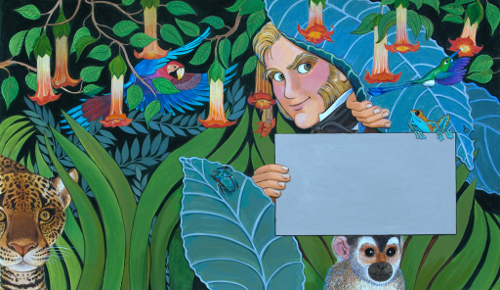
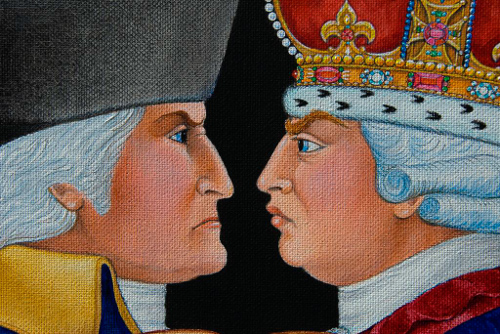


-a.jpg)
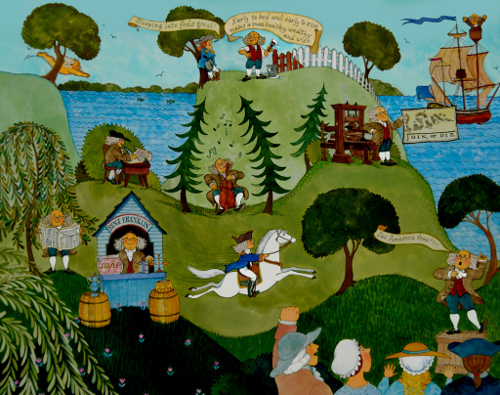
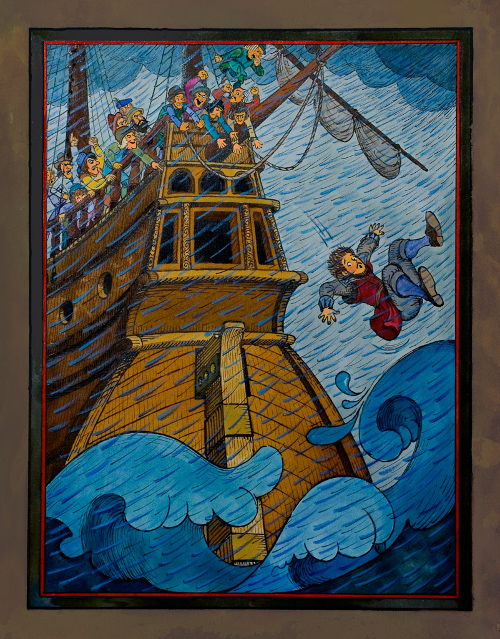

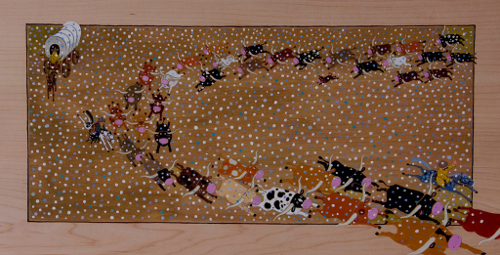
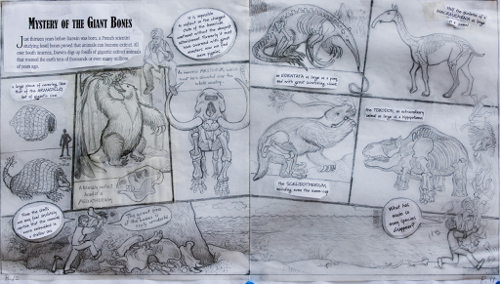


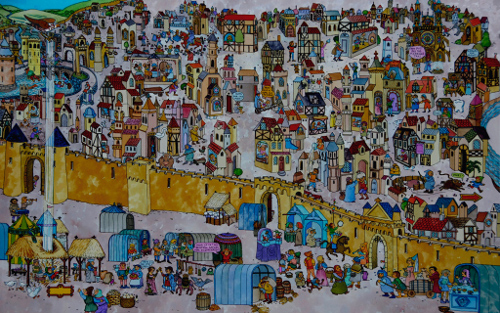

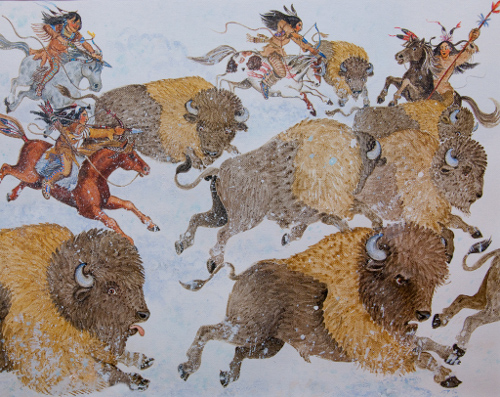
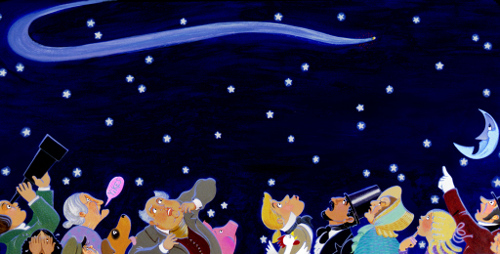
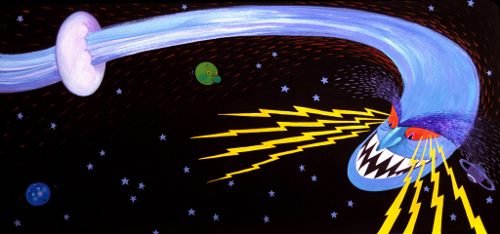

Another stunning interview with one of the great ones. What a great Thursday this is going to be! Thanks.
Wow, great interview! Congrats to Rosalyn on winning that Gold Medal!!
The black and white scratchbord illustrations with those touches of red are positively riveting. And how much do I love that rain forest spread? *swoon* Love her answer to question #7, too :).
I had the pleasure of hearing Rosalyn speak at an SCBWI Conference at GW University years ago, around the time her Lewis & Clark book came out. Since then, I always get excited whenever I come across a title with her name on it. 🙂
Thanks for making my Thursday, R & J!
LOVE the scratchboard. Love, love, love the scratchboard.
What a woman! The description of the studio is mouth watering!
[…] I was surprised to learn that this was Rosalyn’s first scratchboard book. In her interview with Jules Danielson, she states: “. . . I am easily bored, so I’ve tried out almost every media known to man […]
Roz has been my sister for 62+ years (that’s how old I am). I’ve always liked her books – the Ezra maze books [out of print :>( ] are my 2nd favorites. She didn’t say much about Escaping to America (my favorite – cover shown under Question 7). It is about my family (and hers) escaping from the Russian Cossacks and others in Poland to Knoxville, Tennessee. It is a heroic and true adventure, and the drawings look exactly like my father (age 3) and grandparents and family – drawn from photographs. I almost cried when I saw her interpretation of the family portrait in front of a blanket nailed to the barn, taken on the day they left their town in Poland to come to America.
[…] first row (left): An image from John Smith Escapes Again (2006) by Rosalyn Schanzer; first row (top right): This photograph […]